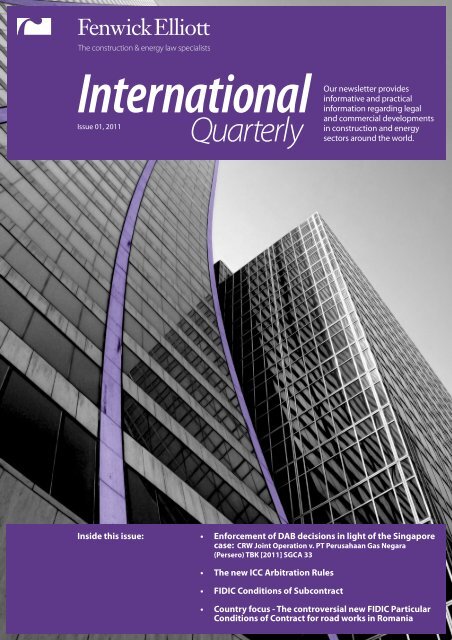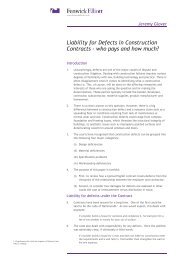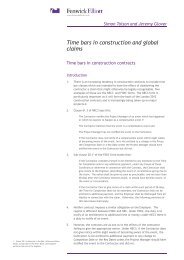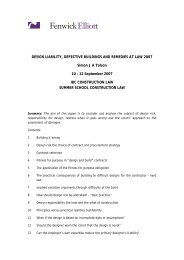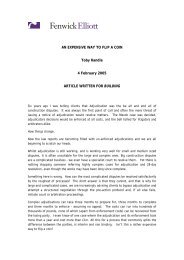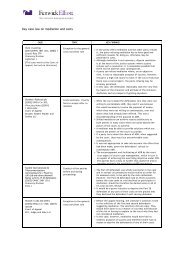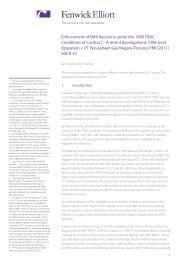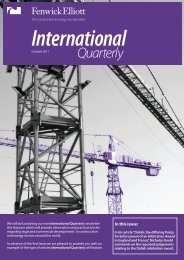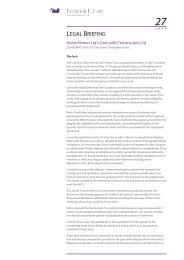download PDF - Fenwick Elliott
download PDF - Fenwick Elliott
download PDF - Fenwick Elliott
- No tags were found...
You also want an ePaper? Increase the reach of your titles
YUMPU automatically turns print PDFs into web optimized ePapers that Google loves.
Issue 01, 2011Our newsletter providesinformative and practicalinformation regarding legaland commercial developmentsin construction and energysectors around the world.Inside this issue:• Enforcement of DAB decisions in light of the Singaporecase: CRW Joint Operation v. PT Perusahaan Gas Negara(Persero) TBK [2011] SGCA 33• The new ICC Arbitration Rules• FIDIC Conditions of Subcontract• Country focus - The controversial new FIDIC ParticularConditions of Contract for road works in Romania
Universal view:International dispute resolution & arbitration Issue 01, 2011case was whether CRW was entitled toimmediate payment by PGN of the sumawarded by the DAB in its Decision of 25November 2008 (“the Dispute”).CRW’s position was that, notwithstandingPGN’s notice of dissatisfaction, PGN stillremained bound by the DAB Decisionand was required to “promptly give effect”to that decision in accordance with Sub-Clause 20.4 of the Conditions of Contract.In its defence, PGN argued that the DABDecision was not “final and binding” asit had served a notice of dissatisfactionand that a binding but not final decisioncould not be converted into a final arbitralaward without first determining whetherthe DAB Decision was correct (or ought tobe revised) on the merits by opening upand reviewing the DAB Decision. PGN inparticular sought to argue that the powersof the Arbitral Tribunal set out in Sub-Clause 20.6 3 did not include the powerto direct a party to make immediatepayment of the sum awarded by theDAB without a review confirming thecorrectness of the DAB Decision.On 24 November 2009, a Final Award wasrendered holding that the DAB Decisionwas binding and that PGN had anobligation to make immediate paymentto CRW of the sum set out in the DABDecision, namely US$ 17,298,834.57. TheArbitral Tribunal also dismissed in its awardPGN’s interpretation of Sub-Clause 20.6and its argument that the Arbitral Tribunalshould open up and review the DABDecision, and noted that PGN still had theright to commence a separate arbitrationto open up, review and revise the DABDecision.CRW then proceeded to register the FinalAward as a judgment in Singapore. Inresponse, PGN applied to set aside theregistration order and also sought anorder from the High Court of Singaporeto set aside the Final Award, on the basisinter alia that the Arbitral Tribunal hadexceeded its jurisdiction by converting theDAB Decision into a Final Award withoutdetermining first whether the DAB wascorrect on the merits.By its decision dated 20 July 2010 (“theHigh Court Decision”), the High Courtof Singapore found in PGN’s favour andset aside the Final Award for lack ofjurisdiction of the Arbitral Tribunal.Dissatisfied with the High Court Decision,CRW filed an appeal, which was dismissedby the Court of Appeal of Singapore in itsjudgment dated 13 July 2011 (“the Courtof Appeal Decision”).The High Court DecisionIn reaching its decision to set aside theFinal Award, the High Court of Singaporeexamined the contractual frameworkset out in Clause 20 for the resolutionof disputes between the Parties andin particular the requirement for adispute to have gone through varioussteps, including a referral of the disputeto the DAB, before it may be referredto arbitration. It also considered thedistinction between the proceedingsenvisaged by Sub-Clauses 20.6 and 20.7 ofthe Condition of Contract.The High Court held that the ArbitralTribunal had acted outside its jurisdictionin two respects:(a)(b)The Dispute that CRWreferred to arbitration in ICC CaseNo. 16122 (namely PGN’s nonpaymentof the sum set out inthe DAB Decision as opposedto the underlying dispute) hadnot been first referred to the DABand was therefore “plainly outsidethe scope of sub-cl 20.6 of theConditions of Contract” 4 , andThe arbitration proceedingscommenced by CRW weremade pursuant to Sub-Clause20.6 of the Conditions ofContract, which, according tothe Singapore court, requires “areview of the correctness of theDAB Decision” 5 and mustbe distinguished fromproceedings brought underSub-Clause 20.7 which do notrequire the arbitral tribunal toconsider the merits of theDAB decision. That distinctionmeant, according to theSingapore court, that the ArbitralTribunal had acted outsideits jurisdiction by making final abinding DAB decision withoutfirst hearing the merits of thatDAB decision.3 Sub-Clause 20.6 of the Conditions of Contract: “The arbitrator(s) shall have full power to open up, review and revise any certificate, determination, instruction,opinion or valuation of the Engineer, and any decision of the DAB, relevant to the dispute.”4 Judgment, paragraph 31.5 Judgment, paragraph 37.
Universal view:International dispute resolution & arbitration Issue 01, 2011What should CRW have done, accordingto the Singapore Court, to enforce itsbinding but not final DAB decision? TheSingapore court dismissed the simpleoption of a referral to arbitration of thelosing party’s failure to comply with theDAB decision. It held obiter that a winningparty should do the following: (1) refer theunderlying dispute covered by the DABdecision to arbitration and ask the ArbitralTribunal to review and confirm the DABdecision; and (2) include a claim for aninterim award in respect of the amountwhich the DAB ordered the losing partyto pay.The Court of Appeal DecisionAlthough the Court of Appeal ultimatelyconfirmed the High Court Decision to setaside the Final Award, the basis on whichit reached its decision is quite different.The basis for the Court of Appeal Decisiondated 13 July 2011 essentially lies withthe matters which the Arbitral Tribunalwas appointed to decide as set out inthe Terms of Reference signed by theparties. The Court of Appeal explains thefollowing:“The TOR stated clearly that theArbitration was commenced pursuant tosub-cl 20.6 of the 1999 FIDIC Conditionsof Contract. Further, it is plain that underthe TOR, the Arbitral Tribunal was, by theparties’ consent, conferred an unfettereddiscretion to reopen and review eachand every finding by the Adjudicator.In other words, the Arbitral Tribunal wasappointed to decide not only whetherCRW was entitled to immediatepayment of the sum of S$17,298,834.57...but also “any additional issues of factor law which the Arbitral Tribunal, in itsown discretion, [might] deem necessaryto decide for the purpose of renderingits arbitral award”” 6 .With what the Court of Appeal describesas “this crucial backdrop in mind”, it wenton to consider whether the Final Awardwas issued in accordance with Sub-Clause20.6. The Court of Appeal found that, byrefusing to open up, review and revisethe DAB Decision and proceeding insteadto make a final award without reviewingthe merits of that decision, the ArbitralTribunal had ignored the clear languageof Sub-Clause 20.6 to “finally [settle]” thedispute between the parties. The Courtof Appeal considered that “What theMajority Members ought to have done,in accordance with the TOR [Terms ofReference] (and, in particular, sub-cl 20.6of the 1999 FIDIC Conditions of Contract),was to make an interim award in favourof CRW for the amount assessed by theAdjudicator (or such other appropriateamount) and then proceed to hear theparties’ substantive dispute afresh beforemaking a final award.” 7The Court of Appeal considered that theFinal Award was therefore not issuedin accordance with Sub-Clause 20.6,which in turn raised the question ofwhether the Arbitral Tribunal exceededits jurisdiction in making the Final Award(Article 34(2)(a)(iii) of Model Law) andwhether it breached the rules of naturaljustice (Section 24(b) of the SingaporeInternational Arbitration Act). These werethe two grounds relied upon by PGNfor setting aside the Final Award andaccepted by the Court of Appeal in thisappeal 8 .Implications of the Singapore caseThe implications of these decisionsfrom the High Court and the Court ofSingapore are difficult to predict. Onething is certain, the conclusion of the HighCourt is already being relied upon in otherarbitration proceedings in support ofdefences to claims for immediate paymentof amounts awarded by DABs as well as inenforcement proceedings. For this reason,the decisions of the High Court and theCourt of Appeal of Singapore merit carefulexamination.A thorough analysis of the High CourtDecision shows that the SingaporeCourt seems to have been misguidedin its interpretation of Sub-Clauses 20.6and 20.7. There is nothing in the FIDICConditions of Contract which wouldprevent a winning party from referringto arbitration simply the issue of theother party’s failure to comply with a DABdecision, as a second dispute, withouthaving to refer also the underlying6 Court of Appeal Decision, paragraph 437 Court of Appeal Decision, paragraph 79.8 PGN did not dispute the decision of the High Court to reject its submissions on Article 34(2)(a)(iv) of the Model Law, namely that “the arbitral procedure wasnot in accordance with the agreement of the parties, which required the merits of the underlying dispute and/or the question of whether the DAB Decisionwas made in accordance with the Contract to be determined prior to making that decision a final award” (High Court Decision, paragraph 9).
Universal view:International dispute resolution & arbitration Issue 01, 2011dispute. It should therefore be possiblefor a winning party to commence arelatively straightforward arbitrationsimply based on the other party’s breachof Sub-Clause 20.4. Only one conditionshould not be overlooked by the winningparty before doing so: that second disputemust have been first referred to the DABand an adequate and timely notice ofdissatisfaction must have been served inrespect of that second DAB decision.In that respect, the High Court ofSingapore was correct when it concludedthat since the Dispute which CRW referredto arbitration (namely PGN’s non-paymentof the sum set out in the DAB Decision)had not been first referred to the DAB,it was plainly outside the jurisdiction ofthe Arbitral Tribunal. This was the rightconclusion given the current wording ofSub-Clause 20.7. Sub-Clause 20.7 makesclear that the only situation where a partymay refer directly to arbitration the otherparty’s failure to give effect to a DABdecision without having to comply firstwith the requirements of Sub-Clause 20.4[Obtaining Dispute Adjudication Board’sDecision] and Sub-Clause 20.5 [AmicableSettlement] is in the event that no partyhas expressed dissatisfaction with the DABdecision and that DAB decision becomesas a result final and binding. In ICC CaseNo. 16122, a notice of dissatisfaction hadbeen given by PGN, making the DABDecision binding but not final. Sub-Clause20.7 was therefore not applicable.It will be interesting to see how theproblem of the enforcement of DABdecisions will be addressed in the secondedition of the 1999 FIDIC Books whichare expected to be published next year.One approach which the FIDIC ContractsCommittee might adopt will be to amendClause 20 along the lines of the FIDICGold Book 2008 by adding in Sub-Clause20.6 that the DAB decision is bindingand the parties have to comply with it“notwithstanding that a Party gives aNotice of Dissatisfaction with such adecision” and by providing in Sub-Clause20.7 9 that in the event that a party failsto comply with a decision of the DAB,whether binding or final and binding,then the other party may refer the failureitself to arbitration without having to referfirst that matter to the DAB and then towait for the amicable settlement period toexpire.These amendments would bringmore certainty to what is currently anambiguous section of the 1999 suiteof FIDIC contracts and would nodoubt give parties more faith in theDAB process and its outcome.A full version of this article waspublished in the September2011 issue of the InternationalConstruction Law Review.Frederic Gillion, Partner<strong>Fenwick</strong> <strong>Elliott</strong>+44 (0)207 421 1986fgillion@fenwickelliott.com9 Interestingly, the Court of Appeal makes no reference to this in its decision.
Commentary:International dispute resolution & arbitration Issue 01, 2011The new ICC Arbitration RulesBy Richard SmelliePartner, <strong>Fenwick</strong> <strong>Elliott</strong>IntroductionThe ICC International Court of Arbitrationhas revised its Arbitration Rules. Thepresent Rules where published in 1998.The new Rules come into effect from1 January 2012. Unless an existing ICCarbitration clause calls for the applicationof the ICC rules as at the date of thecontract, the new rules will apply to anyarbitration commenced after 1 January2012.The ICC International Court of Arbitrationis now arguably the dominant sourceof administered arbitration, and a corebusiness for the International Chamber ofCommerce. The new Rules are an update,and in a number of respects set out thepractice developed by the Court over thepast 10 years, providing transparency andgreater certainty, particularly in relation tomulti party arbitration, consolidation andjurisdictional challenge.A number of the changes are an update:the Chairman of the Tribunal is now thePresident, references to ‘telex’ have beenreplaced with e mail, and the rules aresaid to cover simply “disputes” ratherthan “business disputes” so that there isno suggestion that disputes involvingStates are somehow excluded. The earlyquantification of claims in the Requestfor Arbitration is now encouragedby Article 4(3)(d), and Article 11 nowrequires arbitrators to be impartial, and toconfirm their impartiality (it having beenpreviously assumed that ‘impartiality’was covered by the confirmation of‘independence’). Further by Article 13,where the Court does not accept theproposal of a National Committee, or oneparty is a State, or the President of theCourt considers it necessary, then theCourt now has the power to appoint asarbitrator any person it considers suitable.The much debated topic of confidentialityhas also been addressed. Contraryto the understanding of many usersof international arbitration, it is notautomatically confidential. The newICC Rules do not change that for ICCadministered arbitration, but expresslyprovide at Article 22 (3) that the Tribunalmay, upon the request of the parties, makeorders concerning the confidentiality ofthe arbitration.The most significant changes are in threeareas: case management (which the rulesrequire and actively encourage), interimand conservatory measures (wherethe ICC has introduced an EmergencyArbitrator procedure) and multi partydisputes (which are now provided for,the practice of the Court having beenenshrined in the Rules).Case managementThe 1998 Rules called for the arbitrationto be complete within 6months, andthe practice has been that the Court willapprove extensions to that time frame asneeded (and extensions have usually beenneeded). Under the new Rules, Article 22now includes an express obligation on theparties (as well as the Tribunal) to makeevery effort to conduct the arbitration ‘inan expeditious and cost effective manner’,(Article 22(1))and at 22(2) obliges theTribunal to adopt measures to ensureeffective case management (provided anysuch measures are not contrary to anyagreement of the parties).Article 24, and Appendix IV, are entirelynew. Article 24 requires the Tribunal tocall a case management conference, atthe outset of the proceedings, whenthe Terms of Reference are drawn up(this being a particular feature of ICCarbitration: it is the first task of the Tribunalfollowing receipt of the file from theCourt), or immediately thereafter. Theobjective – and indeed obligation – is toconsult with the parties on proceduralmeasures that might be adopted pursuantto Article 22(2) ‘to ensure effective casemanagement’.In order to further encourage casemanagement, Article 24 calls on theTribunal to hold subsequent casemanagement conferences ‘to ensurecontinued effective case management’,and at 24(4) the Tribunal is empowered to
Commentary:International dispute resolution & arbitration Issue 01, 2011request the attendance of a partyrepresentative at a case managementconference, the intention being to securethe parties ‘buy in’ to effective casemanagement procedures.Appendix IV provides examples of casemanagement techniques that might beadopted. None of the proposals in thisappendix are in themselves radical, butthe appendix provides a useful list ofpossible case management techniques.The list includes various proposals aimedat limiting disclosure, and looking forareas where the parties or their expertsmight agree, limiting the length ofwritten submissions and evidence, andlooking at bifurcation, the use of IT, andgiving consideration to whether thereare issues that might be decided on adocuments only basis. It also includesencouragement to the parties to considersettlement.The case management provisionsconclude at Article 27, where a newobligation is placed upon the Tribunal: atthe conclusion of the proceedings, whenthe Tribunal declares the proceedingsclosed, the Tribunal must now also informthe Secretariat and the parties of the dateby which the Tribunal expects to submitits draft award to the Court for approval.Emergency ArbitratorWhilst the 1998 Rules made provisionfor the issue of interim or conservatorymeasures by the Tribunal onceestablished, they did not provide amechanism for urgent applicationpending the Tribunal being constituted.Consequently parties with an ICCarbitration clause would have to lookto local courts for any urgent interim orconservatory measures, or wait for theTribunal to be constituted – a process thatcould take several months.The new Rules however now provide,at Article 29 and Appendix 5, for theappointment of an Emergency Arbitratorto make orders for urgent interim orconservatory measures, a procedure thathas been included in a number of otheradministered arbitral rules (the SIAC andStockholm rules being examples).Appointment of the Emergency Arbitratoris made upon request to the Secretariat(Article 29(1)). The request must be madebefore the transmission of the file to theTribunal if a Request for Arbitration hasalready been lodged. The appointmentis made by the President of the ICC Court,who also decides whether the emergencyprovisions apply. Further the fee ($40,000)must be paid before the application willbe notified to the Parties under AppendixIV Article 2, and the emergency procedurecommenced.The Emergency Arbitrator must act fairyand impartially, and allow each partyreasonable opportunity to present its case(Appendix IV, Article 5 (2)). By Appendix IV,Article 6(4) the Emergency Arbitrator mustsend his order to the Parties within 15days from the date the file is transmittedto him, and the date of transmissionis expected to be on the emergencyarbitrators appointment, which shouldbe within two days of the request for theappointment having been made (2(1)).If a Request for Arbitration has notalready been made by the partyseeking the urgent interim relief, thatRequest must be made within 10 daysof making application, failing which thePresident must terminate the emergencyproceedings (Appendix IV, Article 1 (6)).It is important to note that by Article 29(2),the emergency arbitrator’s decision takesthe form of an order, and not an award,and by Article 29(3) does not bind theTribunal ultimately established to resolvethe dispute. It is not therefore in thenature of a final, binding decision of anarbitrator, with the result that it is unlikelyto be enforceable as an arbitrator’s award.Its “teeth” however, are found in the powergiven at Article 29(4) to the Tribunalappointed to determine the dispute,to decide upon any claims relating tothe emergency arbitrator proceedings.Noncompliance with an emergencyarbitrator’s order could, therefore, result ina claim.It is also important to note that the Partiesare expressly given the option to opt-outof these provisions. As arbitration is aprocess born of contract, parties could, byagreement, say that any particular parts ofthe Rules do not apply, but if that includedrules which the ICC Court considersfundamental to ICC arbitration, then theICC Court would decline to administerthe arbitration. Whether the emergencyarbitrator procedure might be regarded asfundamental is not known, but the Partieshave been given the express right to optout should they so choose.Further, by Article 29(6), these provisionswill not apply to arbitration agreementsentered onto before 1 January 2012,and by Article 29(7), it is not intended toprevent a party applying to local courts forinterim or conservatory relief.
Commentary:International dispute resolution & arbitration Issue 01, 2011Multi party disputes/multiple contractsFor the first time, the ICC Rules nowinclude provision for multi party disputesand multiple contract arbitrations. Theseare found at Articles 7, 8 and 9, with Article6 (Effect of the arbitration agreement) andArticle 10 (Consolidation of Arbitrations)having been amended to take account ofthe new multi party provisions.It is important to note that theseprovisions do not answer whether aParty might be joined and/or whetherall disputes referred might be heard ina single arbitration. Rather they set outa framework for the resolution of theseissues. The framework reflects the presentpractice of the ICC Court.Article 6 now gives the Court the powerto make a prima facie decision where aproposed Respondent raises an issueas to whether all of the claims made inan arbitration can be heard in a singlearbitration. If the matter is referred to theCourt by the Secretary General, to allowthe arbitration to proceed the Court mustbe satisfied that, for multi Parties, there isprima facie arbitration agreement underthe ICC rules that binds all of the Parties,and for multiple contracts, that thereare prima facie compatible arbitrationagreements and that all Parties haveagreed that the claims can be determinedtogether in a single arbitration.Any decision of the Court remains subjectto the decision of the Tribunal. For thejoinder of additional Parties (Article 7),the Request for Arbitration against theadditional Party must be made before theconfirmation or appointment of any ofthe arbitrators (unless the Parties agreeotherwise), and the request must includeinformation concerning the arbitrationagreement relied upon, and, if there ismore than one arbitration agreement, thearbitration agreement relied upon for eachclaim made.A Party so joined files an Answer, andmay bring a cross claim against any Partyin the arbitration. By Article 8 however,like the Request that joined this Party,where it makes a cross claim its Answermust include information concerningthe arbitration agreement relied upon,and if there is more than one arbitrationagreement, the arbitration agreementrelied upon for each claim made.Through this procedure therefore, anyParty that is joined is given opportunityto play a part in the constitution of theTribunal, and to raise any jurisdictionalobjection from the outset. Further, andimportantly, the Tribunal is provided withthe basic information it will need wherethere is an issue as to jurisdiction.Article 9 supplements these provisions,by confirming that subject to the Courtallowing the arbitration to proceedunder Article 6, claims arising from morethan one contract can be brought in asingle arbitration. This does not howeverimpinge on the Tribunal’s authority todetermine any jurisdictional issue thatmight be raised.Finally, by Article 10, the Court is nowempowered to consolidate arbitrationswhere claims are made under morethan one arbitration agreement, andthe disputes arise in connection withthe same legal relationship, and wherethe Court finds that the arbitrationagreements are compatible.ConclusionThe new ICC Rules are to be welcomed.They bring the ICC Rules up to date,and into line with modern practice andexpectations. There will inevitably besome uncertainty as to how some of themore complex provisions concerningemergency arbitrators and multi partydisputes will work, but the new Ruleshave been carefully thought through anddrafted, and appear fit for purpose.Richard Smellie, Partner<strong>Fenwick</strong> <strong>Elliott</strong>+44(0)207 421 1986rsmellie@fenwickelliott.com
Universal view:International contractual issues around the globe Issue 01, 2011FIDIC Conditions of SubcontractBy Jeremy GloverPartner, <strong>Fenwick</strong> <strong>Elliott</strong>Quietly, in fact so quietly you maynot have noticed, FIDIC has recentlypublished its Conditions of Subcontractfor Construction for use with the 1999FIDIC Red Book 1 . The test edition cameout in 2009 with the formal versionbeing released in October 2011. Therehave only been very minor changesbetween the two. The subcontractformally replaces the FIDIC Conditionsof Subcontract for Works of CivilEngineering Construction, 1st Edition1994.In short the subcontract is intended tooperate in the usual back-to-back basis,and, unsurprisingly, the subcontractprovides for a direct total pass down ofrisk, with the subcontractor assuming theduties and obligations of the contractorunder the main contract.This includes, at sub-cl.4.1, a fitnessfor purpose obligation in respect ofany design work, something which isnot in the 1994 version. This principlealso applies to payment and one thingthat will be of particular note to thosefamiliar with operating in the UK marketis inclusion of pay-when-paid conditionsat sub-cl.14.6. These pay-when-paidprovisions, of course, conflict with thepayment requirements of the HousingGrants Act. FIDIC has included guidancenotes and particular sample conditionsto assist parties working in the UK andother jurisdictions with similar legislation.This is part of the general recognitionon the part of FIDIC that while most ofthe clauses will be generally applicable,there may be some clauses which must,of necessity be amended to take accountof the circumstances and locality of theSubcontract Works.One of the sub-clauses which providedmuch comment under the test edition,and which has been retained here, arethe programming obligations undersub-cl.8.3 and Annex F. Indeed, whilst theprogramming obligations of sub-cl.8.3 ofthe main contract are fairly extensive, theyare much less detailed than thethe programming obligations underthe FIDIC Subcontract 2011. Theserequirements are considerably moredetailed both than those to be foundin the 1994 version. This is even thoughsub-cl.8.5 notes that the Subcontractormonthly progress reports need only bein the same detail and format as theContractor Reports. Annex F of the FIDICSubcontract 2011 alone lists some 17separate requirements, a-q. These includelogically linking all activities, identifyingthe critical path and all float, as well asincluding sufficient flexibility to interfacethe Subcontractor’s activities with theContractor. The Subcontract programmemust be submitted to the Contractorwithin 14 days of receiving the Letterof Acceptance. Then the Contactor has14 days to either approve or reject theprogramme. If the Contractor fails torespond then the initial programmebecomes the Subcontract programmeby default. The programme must beupdated within seven days of theoccurrence of one of six-listed eventsincluding the Subcontractor changinghis methods or sequencing, there beingany delay which impacts on the criticalpath or the Subcontractor receiving fromthe Contractor an instruction, pursuantto sub-cl.8.4 to accelerate where theSubcontractor’s progress is too slow.Employers under the FIDIC Red Book 1999,may well, if they are not already, startrequiring a similar level of detail from theContractor.Subcontractor claimsAs always, FIDIC has given considerableattention to the dispute resolutionprovisions. The subcontract containsits own dispute resolution proceduresbut as you would expect, the claimsprocedure for Subcontractors set outin the FIDIC Subcontract 2011 followsthe scheme of the FIDIC Red Book 1999.1It is also intended to be used in conjunction with the FIDIC Conditions of Contract for Construction, MDB Harmonised Edition or Pink Book. However if this is the caseboth parties must take care to ensure that the subcontract has been amended to mirror the differences between the Pink and Red Books.
Universal view:International contractual issues around the globe Issue 01, 2011Indeed the Subcontract perfectly mirrorsthe Main Contract such that there is nocondition precedent attached to thetime in which a Contractor must bring aclaim, but the equivalent requirementson a Subcontractor are expressed in thisway, albeit that this is only done by crossreferenceand so the Subcontractor wouldonly know this by referring to sub-cl.20.1of the FIDIC Red Book 1999. Thereforeif the Subcontractor puts in his claimoutside of the time limit, the right to bringthe claim might be lost for good, howevermeritorious the claim might otherwisebe. Any such notice must be given within21 days, in order to give the Contractorthe chance to give timely notice to theEmployer, if appropriate. The remainingtimescales are similarly shortened, suchthat the detailed claim must be submittedwithin 35 and not 42 days.Then the Contractor is required to consultwith the Subcontractor to try and reachagreement on the claim, failing whichthe Contractor must then, within 42 daysafter receipt of the detailed claim, go on tomake a “fair determination” of the claim.Sub-clause 20.3 of the FIDIC Subcontract2011 notes that if by reason of anyfailure by the Subcontractor to followthe requirements set out in sub-cl.20.1and 2, the Contractor is preventedfrom recovering any sum other than inrespect of a Subcontractor claim thenthe Contractor, provided it follows theappropriate claims process itself, shallbe entitled to deduct that sum from theSubcontract Price.Subcontractor claims to the DABThe general scheme under the 1999 Redbook is this:(i) A dispute is referred to the DAB;(ii) The DAB then has 84 days to reach itsdecision;(iii) A party then has 28 days to serve aNotice of Dissatisfaction otherwisethat Decision becomes binding;(iv) There is then a 56-day period foramicable settlement; and if there is nosettlement then(v) A reference can be made toArbitration.The provisions of the FIDIC Subcontract2011 take steps to try and ensure thatdisputes arising out of the Subcontractcan be dealt with, without prejudicingthe rights of either the Contractor (andtherefore possibly the Subcontractor too)under the main Contract.Sub-cl.20.4, provides that if the Contractorconsiders 2 that the dispute raised by theSubcontractor is a dispute which involvesan issue related to a dispute between theContractor and Employer under the mainContract then, the Parties shall (a) deferreferral of the dispute to the Subcontractfor 112 days and (b) if the dispute hasnot been previously referred under themain Contract, the Contractor must referthe new dispute within 28 days. This is apositive obligation on the Contractor. TheSubcontractor is understandably obligedto give the Contractor in good time anyassistance that may be required 3 duringthe hearing process.Under sub-cl. 20.4 of the FIDICSubcontract 2011, the Subcontractorwill not be bound by the DAB Decisionunder the main Contract, but this shouldbe checked as the particular conditionsgive an alternative cl.20 to be used wherethe Subcontractor is to be bound by adetermination. If no notice is given by theContractor that the dispute is a RelatedIssue then either party is entitled to referthe dispute to the Subcontract DAB.This new Subcontract is a further stepalong the FIDIC road to standardisationand as such it is a welcome addition as ithas been specifically drafted to complywith the Red and Pink Books. Of course,to fully understand the risks and liabilities,as with every subcontract, the onus willbe on all parties to read the subcontracttogether with the applicable mainContract.Jeremy Glover, Partner<strong>Fenwick</strong> <strong>Elliott</strong>+44(0)207 421 1986jglover@fenwickelliott.com2This view can be challenged by the Subcontractor if he serves a notice in writing. The question would be decided by a pre-arbitral referee, using the ICC Rules for PrearbitralReferee Procedure.3And the Subcontractor is entitled to be involved, for example in any consultation with the Engineer.
Insight: RomaniaInternational focus on countries and sectors Issue 01, 2011The controversialnew FIDIC ParticularConditions ofContract for roadworks in RomaniaBy Frederic GillionPartner, <strong>Fenwick</strong> <strong>Elliott</strong>In March 2011, the Romanian governmentintroduced new FIDIC conditions of contractapplicable to road works, officially toaddress inconsistencies between the FIDICforms of contract and Romanian legislation.Those new conditions of contract havequickly caused much controversy amongthose contractors which are tendering forroad works in Romania and were even thesubject of a joint statement issued by theEuropean Construction Industry Federation(FIEC) and the European InternationalContractors (EIC) and addressed to theEuropean Commission in May 2011.Making standard and compulsory particularconditions of contract so as to meet localrequirements and regulations is fairlycommon and obviously totally acceptable.However what is questionable is theattempt of the Romanian government tochange the allocation of risks in the process.The change in the allocation of risks hasbeen particularly significant with theYellow Book as the new conditions ofcontract have literally imported entireprovisions from the Silver Book (applicableto turnkey projects) when FIDIC itselfrecognizes that this form is not a balancedform of contract and that it should not beused “if construction will involve substantialunderground work”. Having Silver Bookprovisions relating to the Contractor’sresponsibility for unforeseen events andthe Employer’s Requirements applied toroad projects is clearly worrying.A quick review of some of the changesintroduced by those new conditionsof contract is sufficient to explain whyinternational contractors are becomingincreasingly cautious about the newinvitations to tender launched this yearunder these new conditions of contract. Ina nutshell: additional risks have been shiftedto the Contractor and the Contractor’sentitlement to claim under the Contracthas been significantly restricted.Contractor’s • right of access to the Site(Sub-Clause 2.1) - The Contractor waivesany right to claim in respect of the handingover of the Site in sections irrespective ofthe size of those sections, their locationor the additional costs associated with acompletion of the Works in sections.Unforeseeable Physical Conditions (Sub-Clause 4.12) – Here the provisions of Sub-Clause 4.12 of the Silver Book [UnforeseenDifficulties] have been introduced, whichmeans that the Contractor is deemed tohave obtained all necessary informationas to risks, contingencies and othercircumstances which may influence oraffect the Works. Unquantifiable riskssuch as risks for ground conditions, fossils,archaeological findings have now beentransferred to the Contractor.Responsibility for the accuracy of theEmployer’s Requirements (Sub-Clause5.1 of the Yellow Book) – In the same vein,by adopting more or less the provisionsof Sub-Clause 5.1 of the Silver Book, theContractor is now responsible for theaccuracy of the Employer’s Requirements.Delay damages – Delay damages cannow be levied in the event that specificmilestones are not met. However, if thefinal milestone is eventually met, those
Insight: RomaniaInternational focus on countries and sectors Issue 01, 2011Arbitration (Sub-Clause 20.6) – Animportant, although not obvious, changeas been introduced by the new conditionsof contract in relation to the arbitrationclause. Although Sub-Clause 20.6 has notbeen amended per se, Sub-Clause 1.4has been amended to the effect that thelanguage for communications under theContract is now Romanian. In practice,this means that by virtue of paragraph(c) of Sub-Clause 20.6, the language tobe used in any arbitration proceedingsis also Romanian unless this paragraph isamended.delay damages that have been paid shallbe reimbursed.Payments under the Contract shall notexceed 110% of the Accepted ContractAmount – regardless of the causes leadingto the additional costs (except in the eventof a price adjustments resulting from Sub-Clauses 13.7 [Changes in Legislation] and13.8 [Changes in Costs]).Delayed payment - The Contractor isdeemed to have waived its right to intereston late payment if no invoice is issuedwithin two months and the Employer is alsogiven an additional 45 days (in addition tothe 56 days from the Engineer’s certificate)before having to pay the Contractor.The Contractor’s right to suspend workhas been significantly restricted (Sub-Clause 16.1) – This can only be done after183 days from the Employer’s notificationas opposed to 21 days.Termination by Employer (Sub-Clause15.2) and by Contractor (Sub-Clause16.2) – Conscious that the exceptionallyhigh number of termination cases clearlyaffected the completion of major roadprojects in Romania, a solution wasfound by the Ministry of Transport withthe following amendment to Sub-Clause16.2: termination will only take effectafter having obtained a final and bindingDAB (which is unlikely to happen as theEmployer will undoubtedly issue a noticeof dissatisfaction) or an arbitral awardconfirming the Contractor’s entitlementto terminate and the effectiveness ofsuch termination. This means that theContractor is completely deprived inpractice from its right to terminate theContract as the Contractor will be requiredin the meantime, under the new conditionsof contract, to comply with its obligationsunder the Contract irrespective of its noticeof termination and the Employer’s failures.The above changes introduced by thenew FIDIC conditions of contract haveso drastically modified the original FIDICconditions of contract that one can nolonger describe them as either fair orbalanced. The pressure exercised recentlyby European contractors and organizationsrepresenting them for a rapid change inlegislation is a welcome move. Until thena number of experienced contractors nowrefrain from tendering for road projectsin Romania. This is obviously not in theinterest of Romania and certainly not of theEU which is financing a very large portionof these projects.Frederic Gillion, Partner<strong>Fenwick</strong> <strong>Elliott</strong>+44 (0)207 421 1986fgillion@fenwickelliott.com
News and EventsTrends, topics and breaking news from <strong>Fenwick</strong> <strong>Elliott</strong> Issue 01, 2011International Quarterly first editionWe hope that you have found thisfirst edition of International Quarterlyboth informative and useful. We aimto keep you updated regarding legaland commercial developments inconstruction and energy sectors aroundthe world. <strong>Fenwick</strong> <strong>Elliott</strong>’s team ofspecialist lawyers have advised onnumerous major construction and energyprojects worldwide, nurturing schemesto completion with a combination ofcareful planning, project support and riskassessment. From document preparationto dispute resolution, our services spanevery stage of the development process.We also offer bespoke training to ourclients on various legal topics affectingtheir business – for example, earlier thisyear we hosted a very successful halfday seminar and workshop in Bucharest,on the use of the FIDIC Yellow Book forinfrastructure projects in Romania. If youare interested in receiving bespoke inhousetraining please contact Susan Kirbyskirby@fenwickelliott.com for a list of topics.Our international workOur firm continues to secure instructionson projects outside the UK. In recentmonths we have received instructionsrelating to power and desalination plantsin the Middle East and road projects and aland fill site in Eastern Europe.Launch of new <strong>Fenwick</strong> <strong>Elliott</strong> websiteWe are delighted to announce that wehave launched our new websitewww.fenwickelliott.com . The new lookwebsite provides examples of our workand features a comprehensive “Researchand insight” section hosting articlesand papers written by <strong>Fenwick</strong> <strong>Elliott</strong>colleagues on various construction andenergy law topics.Annual Review 2011/2012Our annual publication which containsa round up of the key developments inthe construction, engineering and energyarena is now available to <strong>download</strong> fromour website . If you would like to receivea hard copy of this Review please contactSusan Kirby skirby@fenwickelliott.comAbout the editor, Jeremy GloverJeremy has specialised in constructionenergy and engineering law and relatedmatters for most of his career. He adviseson all aspects of projects both in the UKand abroad, from initial procurementto where necessary dispute avoidanceand resolution. Typical issues dealt withinclude EU public procurement rules,contract formation, defects, certificationand payment issues, disruption, loss and/or expense, prolongation, determinationor repudiation and insolvency.He has advised clients in internationalarbitrations under ICC, UNCITRAL and adhoc rules as well as in relation to all sizesof domestic disputes. He is an accreditedadjudicator and regularly advises on boththe conduct of adjudication and theenforcement of adjudicator’s decisions.Jeremy is also increasingly involved in thedispute resolution opportunities offeredby mediation, expert determination andother forms of ADR.Jeremy is the co-author of UnderstandingThe New FIDIC Red Book: A Clause byClause Commentary. He also works withRobert <strong>Fenwick</strong> <strong>Elliott</strong> preparing annualupdates of Building Contract Disputes:Practice and Precedents. Jeremy is amember of the Board of Examiners onthe Centre of Construction Law MScprogramme at King’s College, Londonwhere he also teaches on adjudicationand FIDIC issues. Jeremy organises andregularly addresses <strong>Fenwick</strong> <strong>Elliott</strong> hostedseminars and provides bespoke in-housetraining to clients. He also edits <strong>Fenwick</strong><strong>Elliott</strong>’s monthly legal bulletin, Dispatch.International Quartely is producedquartely by <strong>Fenwick</strong> <strong>Elliott</strong> LLP, theleading specialist construction lawfirm in the UK, working with clientsin the building, engineering andenergy sectors throughout theworld.International Quartely is anewsletter and does not providelegal advice.Edited by Jeremy Glover, Partner, <strong>Fenwick</strong> <strong>Elliott</strong> LLPjglover@fenwickelliott.com Tel: + 44 (0) 207 421 1986<strong>Fenwick</strong> <strong>Elliott</strong> LLPAldwych House71-91 AldwychLondon , WC2B 4HNwww.fenwickelliott.com


